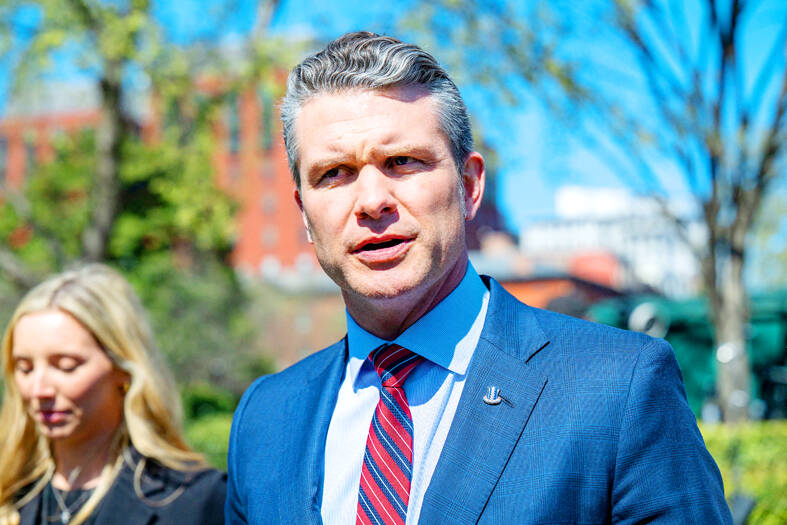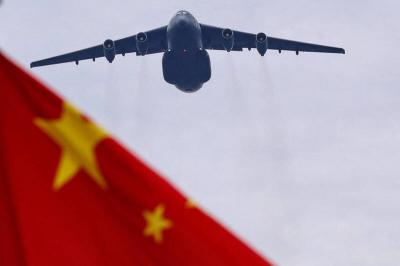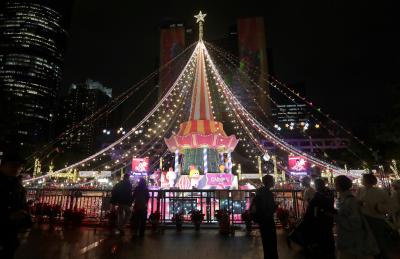The US is reorienting its military strategy to focus primarily on deterring a potential Chinese invasion of Taiwan, a memo signed by US Secretary of Defense Pete Hegseth showed. The memo also called on Taiwan to increase its defense spending.
The document, known as the “Interim National Defense Strategic Guidance,” was distributed this month and detailed the national defense plans of US President Donald Trump’s administration, an article in the Washington Post said on Saturday.
It outlines how the US can prepare for a potential war with China and defend itself from threats in the “near abroad,” including Greenland and the Panama Canal, the article said.

Photo: AFP
The document said the US would adopt a “denial defense” strategy to protect Taiwan in case of a Chinese invasion.
That strategy involves increasing the US’ military presence through bombers, uncrewed ships, submarines and specialty units, and strengthening the defense of US military bases in the Indo-Pacific region, it said.
The administration of former US president Joe Biden and that of Trump’s first term “characterized China as the greatest threat to the US, and postured the force to prepare for and deter conflict in the Pacific region,” the article said.
The memo also said that a potential Chinese invasion of Taiwan must be prioritized over other dangers, requiring US military deployments to be reassessed with a greater focus on the Indo-Pacific region.
The US would pressure allies in Europe, the Middle East and East Asia to take on the bulk of the role in deterring Russia, North Korea and Iran, the memo said.
“China is the [US] Department [of Defense]’s sole pacing threat, and denial of a Chinese fait accompli seizure of Taiwan — while simultaneously defending the US homeland is the department’s sole pacing scenario,” Hegseth said in the memo.
The memo also called for “pressuring” Taiwan to significantly increase its defense spending.
The document is strikingly similar to a longer report published last year by the Heritage Foundation, titled “Project 2025,” the article said.
Although Trump denied that the plan was a blueprint for his second term during the election campaign, the document shows that the foundation’s plans have been deeply influential to his policies, it said.
Asked for comment, Democratic Progressive Party Legislator Chen Kuan-ting (陳冠廷) in Taipei yesterday said the memo showed that the US is adjusting its military strategies to focus on Taiwan and the Indo-Pacific region.
Taiwan should respond to the US’ strategic adjustments by investing more resources to bolster its capacity for self-defense, Chen said, adding that the nation should recognize the US’ strong commitment to the region and strengthen regional cooperation.
Institute for National Defense and Security Research research fellow Su Tzu-yun (蘇紫雲) said that Hegseth’s memo, which prioritizes “deterring China’s actions to seize Taiwan,” stems from a shift in US overall strategy.
The shift introduced a “reverse Nixon” strategy, emphasizing Asia over Europe to concentrate efforts on countering China, Su said.
It also addresses China’s shift from a land-based military power to a marine power, which poses a threat to major marine trade routes, he said.
Although the expression is different in the way Hegseth’s discourse is rendered, it is similar to the US’ past promises that reiterated its commitment to Taiwan, he said.
Additional reporting by Huang Chin-hsuan

Beijing could eventually see a full amphibious invasion of Taiwan as the only "prudent" way to bring about unification, the US Department of Defense said in a newly released annual report to Congress. The Pentagon's "Annual Report to Congress: Military and Security Developments Involving the People's Republic of China 2025," was in many ways similar to last year’s report but reorganized the analysis of the options China has to take over Taiwan. Generally, according to the report, Chinese leaders view the People's Liberation Army's (PLA) capabilities for a Taiwan campaign as improving, but they remain uncertain about its readiness to successfully seize

Taiwan is getting a day off on Christmas for the first time in 25 years. The change comes after opposition parties passed a law earlier this year to add or restore five public holidays, including Constitution Day, which falls on today, Dec. 25. The day marks the 1947 adoption of the constitution of the Republic of China, as the government in Taipei is formally known. Back then the Chinese Nationalist Party (KMT) governed China from Nanjing. When the KMT, now an opposition party in Taiwan, passed the legislation on holidays, it said that they would help “commemorate the history of national development.” That

Taiwan has overtaken South Korea this year in per capita income for the first time in 23 years, IMF data showed. Per capita income is a nation’s GDP divided by the total population, used to compare average wealth levels across countries. Taiwan also beat Japan this year on per capita income, after surpassing it for the first time last year, US magazine Newsweek reported yesterday. Across Asia, Taiwan ranked fourth for per capita income at US$37,827 this year due to sustained economic growth, the report said. In the top three spots were Singapore, Macau and Hong Kong, it said. South

Snow fell on Yushan (Jade Mountain, 玉山) yesterday morning as a continental cold air mass sent temperatures below freezing on Taiwan’s tallest peak, the Central Weather Administration (CWA) said. Snowflakes were seen on Yushan’s north peak from 6:28am to 6:38am, but they did not fully cover the ground and no accumulation was recorded, the CWA said. As of 7:42am, the lowest temperature recorded across Taiwan was minus-5.5°C at Yushan’s Fengkou observatory and minus-4.7°C at the Yushan observatory, CWA data showed. On Hehuanshan (合歡山) in Nantou County, a low of 1.3°C was recorded at 6:39pm, when ice pellets fell at Songsyue Lodge (松雪樓), a